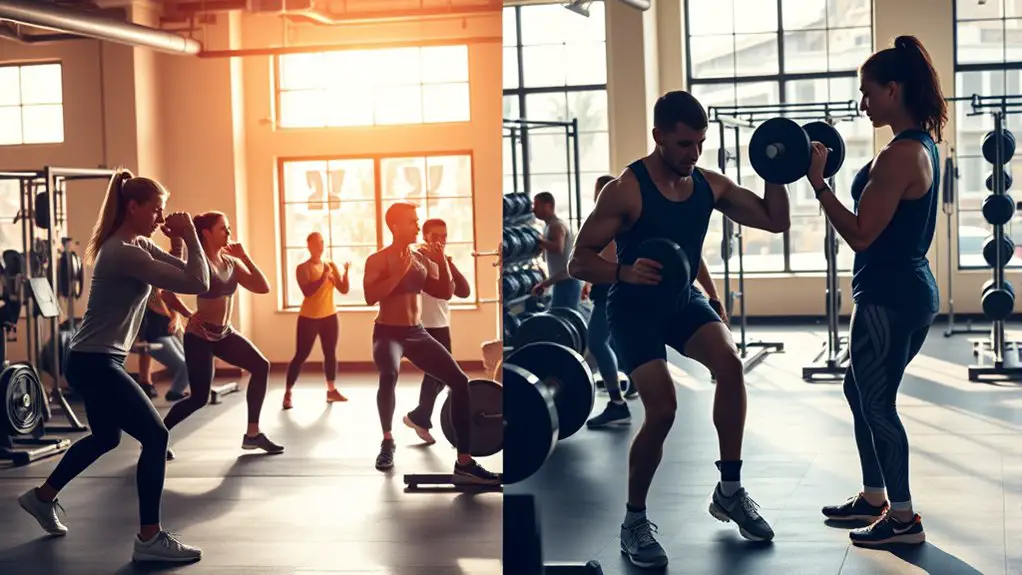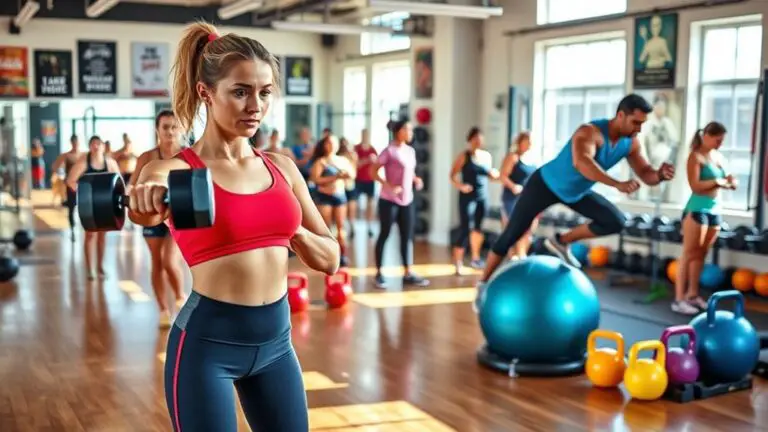Compound vs. Isolation Exercises: Which Is Better?

When considering compound vs. isolation exercises, it really depends on your goals. Compound exercises work multiple muscle groups, boosting overall strength and efficiency. On the other hand, isolation exercises help target specific muscles, perfect for correcting imbalances. To get the best results, a balanced routine incorporating both types is ideal. By focusing on your individual needs and preferences, you can maximize your workout. Want to learn how to design that balanced routine? Let’s explore further!
Understanding Compound Exercises

When you think about building strength effectively, compound exercises often come to mind. These exercises engage multiple muscle groups at once, leading to greater muscle recruitment compared to isolation exercises. This means you’re not just working one muscle but several, which can enhance your overall strength and functional fitness.
Safety is key, so it’s vital to use proper form and start with manageable weights to avoid injuries. Compound exercises, like squats and deadlifts, also require more energy expenditure, making them efficient for burning calories while building strength. This increased energy output means you’re getting more benefits in less time, which is essential if you’re looking to maximize your workouts. Additionally, aiming for an elevated heart rate of 60-80% of maximum heart rate during these exercises can help ensure you’re pushing yourself effectively.
Benefits of Compound Exercises
When you incorporate compound exercises into your routine, you’re engaging multiple muscle groups at once, which can boost your overall strength. These exercises also save you time, allowing you to get a full workout in less time. Plus, they enhance functional strength, making everyday activities easier and more efficient.
Full-Body Muscle Engagement
While many workouts focus on isolating specific muscles, compound exercises offer a powerful alternative that engages multiple muscle groups simultaneously. When you perform these exercises, you not only enhance muscle activation but also increase your workout intensity. This means you’re getting more out of each session without putting excessive strain on your body. Engaging various muscle groups helps improve coordination and stability, which can lead to better overall strength and functional fitness. Plus, by using your body’s natural movements, you reduce the risk of injury often associated with isolating exercises. So, if you’re looking for a safe and effective way to boost your fitness routine, incorporating compound exercises can be a game-changer for your physical health.
Time Efficiency Benefits
Incorporating compound exercises not only improves muscle engagement but also greatly boosts time efficiency in your workouts. By targeting multiple muscle groups simultaneously, you can achieve more in less time, making them one of the best time-saving strategies available. Instead of spending hours in the gym, you can accomplish efficient workouts that deliver results without the need for excessive isolation exercises. This allows you to maximize your training session while minimizing the risk of overuse injuries, which is essential for safety. Whether you’re short on time or just looking to streamline your routine, compound exercises offer a practical solution to fit your fitness goals into a busy lifestyle. Embrace these techniques to make the most of your workout time!
Enhanced Functional Strength
Compound exercises greatly enhance your functional strength, as they mimic real-world movements that your body performs daily. By engaging multiple muscle groups and joints, these exercises improve your functional mobility, making everyday tasks easier and safer. When you focus on strength development through compound movements, you’re not just lifting weights; you’re training your body to work as a cohesive unit. This approach reduces the risk of injury during activities like lifting groceries or climbing stairs, as your muscles learn to coordinate effectively. Incorporating compound exercises into your routine allows for balanced strength gains while promoting overall stability. So, if you want to boost your functional strength and enhance your daily performance, consider prioritizing these exercises in your workouts.
Drawbacks of Compound Exercises
While compound exercises offer great benefits, they also come with some drawbacks you should be aware of. The complexity of the techniques can increase your risk of injury, especially if you’re not careful. Additionally, these exercises may contribute to muscle imbalances if certain muscle groups dominate the movements. It’s important to maintain a healthy relationship with exercise to avoid these potential issues.
Higher Injury Risks
Although compound exercises offer numerous benefits, they can also come with higher injury risks, especially for those who aren’t careful with their form. When performing these movements, you’re engaging multiple muscle groups and joints, which can increase the likelihood of strain or injury if you’re not focused on technique. Prioritizing exercise safety is vital; it’s easy to push yourself too hard or overlook proper alignment. To guarantee injury prevention, always start with lighter weights and gradually increase intensity as your strength improves. Consider working with a trainer to learn the correct form and avoid common pitfalls. Remember, taking the time to master your technique will pay off in the long run, keeping you safe while achieving your fitness goals.
Technique Complexity
When you’re tackling compound exercises, the complexity of the required techniques can be a significant drawback. To guarantee safety and effectiveness, consider these key points:
- Exercise Form: Proper form is vital; poor technique can lead to injuries and ineffective workouts.
- Skill Development: Mastering complex movements takes time and dedication, which might overwhelm beginners or those with less experience.
- Coaching Techniques: Effective coaching is essential for learning proper movement patterns; without guidance, it’s easy to develop bad habits.
To achieve technique mastery, focus on progression strategies that allow you to build your skills gradually. Prioritize understanding each movement’s intricacies rather than rushing through workouts. This approach not only enhances your safety but also boosts your overall performance in the long run.
Muscle Imbalance Issues
Muscle imbalances can often arise from focusing primarily on compound exercises, especially if certain muscle groups are favored over others. If you consistently perform exercises like squats or bench presses without targeting weaker muscles, you might develop strength disparities that can lead to injury. For instance, overdeveloped quads may overshadow your hamstrings, compromising muscle symmetry. This lack of balance can affect your overall performance and increase the risk of strains. To promote safety and well-rounded strength, consider incorporating isolation exercises to specifically target underdeveloped areas. By doing so, you’ll enhance muscle symmetry and reduce the chances of injury, ensuring a more balanced and effective workout routine. Remember, a well-rounded approach is key to long-term fitness success.
Understanding Isolation Exercises
Isolation exercises focus on targeting a specific muscle group, making them vital for honing in on particular areas of strength or addressing imbalances. By incorporating these exercises into your routine, you can enhance muscle targeting and introduce valuable exercise variety. Here are three key points to reflect on:
- Form and Technique: Maintaining proper form is essential to prevent injury. Focus on slow, controlled movements to guarantee you’re engaging the intended muscle.
- Recovery Time: Isolated muscles require adequate recovery. Pay attention to how your body feels and allow time for healing to avoid overtraining.
- Balanced Routine: While isolation exercises are beneficial, they should complement compound movements. This balance guarantees overall strength and reduces the risk of muscle imbalances.
Benefits of Isolation Exercises

While many people focus on compound exercises for overall strength, the benefits of isolation exercises shouldn’t be overlooked. Isolation exercises allow you to target specific muscles, which can be especially beneficial if you’re looking to correct muscle imbalances or enhance muscle definition. By concentrating on one muscle group at a time, you can guarantee that you’re engaging it fully, leading to better muscle growth and strength in those areas.
Moreover, isolation exercises can play an essential role in injury prevention. Strengthening specific muscles helps support your joints and can reduce the risk of injuries during other activities or compound movements. This targeted approach allows you to train safely and effectively, giving you the confidence to push your limits without compromising your well-being. Whether you’re a beginner or an experienced lifter, incorporating isolation exercises into your routine can enhance your overall fitness journey and keep you safe.
Drawbacks of Isolation Exercises
Despite the advantages of isolation exercises, there are notable drawbacks to evaluate. While these exercises can target specific muscles, they may lead to some concerns regarding safety and effectiveness. Here are three key drawbacks:
- Muscle Fatigue: Focusing on a single muscle group can quickly lead to fatigue, making it harder to maintain proper form during your workout.
- Joint Stress: Isolation exercises often put excessive stress on your joints, especially if performed incorrectly or with heavy weights. This can lead to injuries over time.
- Limited Functional Strength: These exercises don’t mimic real-life movements, which may hinder your overall strength and functionality in daily activities.
Being aware of these drawbacks helps you make informed decisions about your workout routine. Balance isolation exercises with compound movements to enhance safety and effectiveness while minimizing risks.
When to Use Compound Exercises

Compound exercises are essential when you want to maximize your workout efficiency and engage multiple muscle groups simultaneously. They’re especially beneficial if you’re looking to increase your overall strength and improve your athletic performance. If you’re working out frequently, incorporating compound movements like squats, deadlifts, or bench presses can save you time while delivering significant results.
These exercises not only build muscle but also enhance your coordination and stability, which can help prevent injuries. When your goal is to increase functional strength or prepare for sports, using compound exercises is a no-brainer. Just remember to focus on proper form to guarantee safety and effectiveness. Start with lighter weights to master the technique before progressing. By integrating these movements into your routine, you’ll experience the compound exercise benefits while enjoying a more well-rounded fitness regimen.
When to Use Isolation Exercises
Isolation exercises can be particularly useful when you want to target specific muscles or address imbalances in your body. They allow for precise muscle targeting, which can enhance your overall strength and performance. Here are three situations where isolation exercises shine:
- Rehab and Recovery: If you’re recovering from an injury, isolation exercises can help strengthen specific muscles without overloading others, aiding in injury prevention.
- Muscle Imbalances: They’re great for fixing imbalances; for instance, if one side of your body is weaker, isolation work can help bring it back in line.
- Aesthetic Goals: If you’re aiming to sculpt certain muscles, such as biceps or calves, isolation exercises can be key in refining those areas.
Designing a Balanced Workout Routine
To build an effective workout routine, it’s important to incorporate both compound and isolation exercises. Start with a balance assessment to identify your strengths and weaknesses. This will help you understand which areas need more focus, ensuring you’re not overworking certain muscle groups while neglecting others.
For workout customization, combine compound movements like squats and deadlifts, which work multiple muscle groups, with isolation exercises such as bicep curls and tricep extensions. This approach not only promotes muscle growth but also enhances overall stability and coordination, reducing the risk of injury. Additionally, consider proper workout clothing to ensure comfort during your exercises.
Aim for a balanced routine that targets all major muscle groups at least twice a week. Remember to listen to your body; if something feels off, adjust your exercises accordingly. Prioritizing safety and balance in your workouts will lead to better results and a more enjoyable fitness journey.
Frequently Asked Questions
Can Beginners Start With Compound Exercises, or Should They Focus on Isolation First?
As a beginner, you can definitely start with compound exercises. They’re great for building overall strength and coordination, allowing for a more efficient workout. Focusing on your form is essential, so don’t rush it; prioritize safety. You can incorporate isolation exercises later for targeted muscle work as you progress. Starting with compound movements sets a solid foundation for your exercise progression, helping you become stronger while minimizing the risk of injury.
How Do I Know if I Need More Compound or Isolation Exercises?
Imagine standing in the gym, unsure whether to lift heavier weights or focus on targeted muscles. You need to reflect on your fitness goals and training experience. If you’re aiming for overall strength and efficiency, you might benefit from more compound exercises. However, if you’re looking to sculpt specific muscles or recover from an injury, isolation exercises could be safer and more effective. Listen to your body, and adjust your routine accordingly.
Are There Specific Sports That Benefit More From One Type of Exercise?
Absolutely, certain sports benefit more from specific types of training. For example, athletes in sports like football or basketball often gain from compound exercises, as they enhance overall strength and exercise efficiency. On the other hand, sports like bodybuilding may require more isolation exercises to target specific muscles. It’s essential to tailor your workout to your sport, ensuring you’re training safely and effectively to meet the demands of your athletic performance.
Is It Safe to Perform Compound Exercises Without a Spotter?
It’s generally not recommended to perform compound exercises without a spotter, especially when lifting heavy weights. To guarantee your safety, make sure you’ve mastered your exercise technique first. Using proper form can help prevent injuries, but having someone there can provide immediate assistance if needed. Always take necessary safety precautions, like using safety bars or lifting lighter weights until you’re confident. Your safety should always come first in any workout routine.
Can I Combine Compound and Isolation Exercises in the Same Workout?
Absolutely, you can combine compound and isolation exercises in the same workout! This approach can boost your workout efficiency and provide exercise variety, keeping your routine engaging. Just make sure to balance the intensity and volume, so you don’t overexert yourself. Starting with compound movements when you’re fresh is a great strategy, followed by isolation exercises to target specific muscles. Always prioritize safety, and listen to your body throughout your session!





